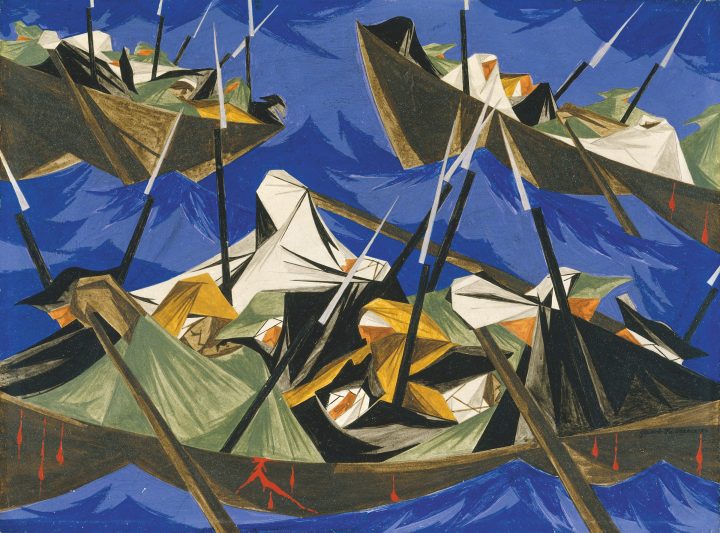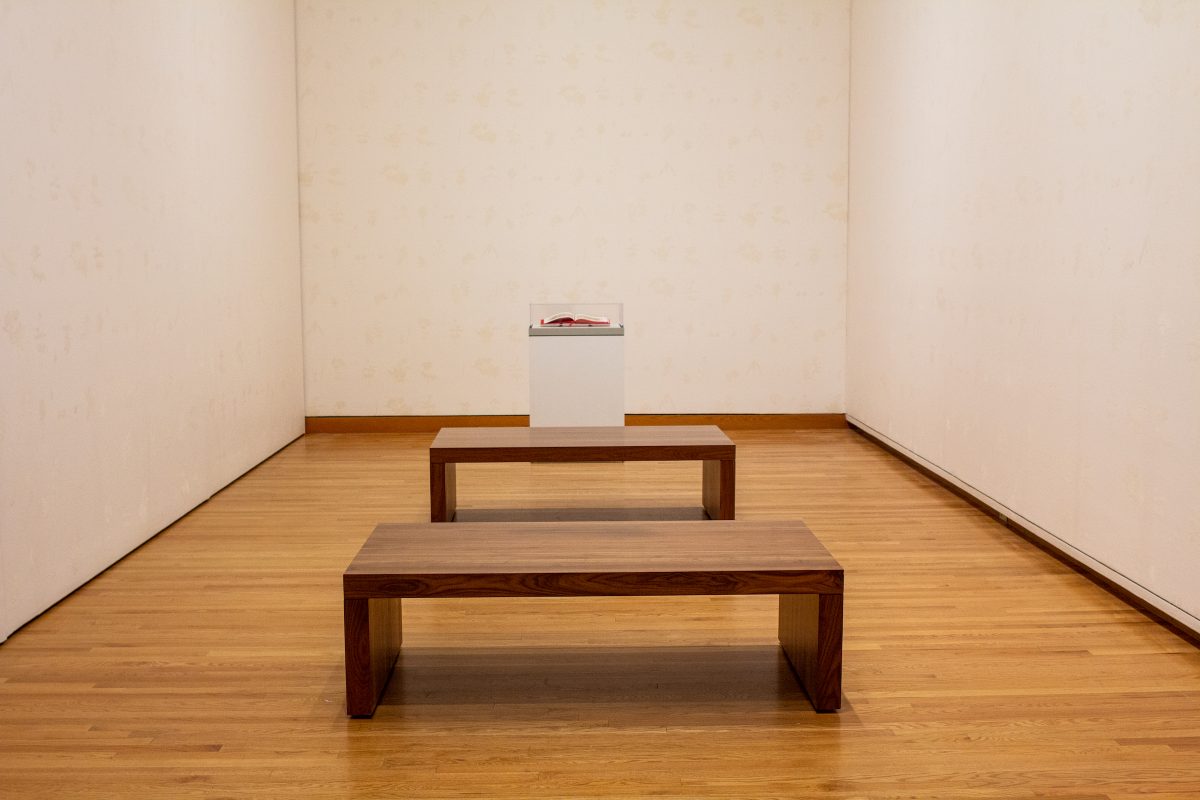
SEATTLE — Four years ago, patrons packed the Seattle Art Museum (SAM) to view Jacob Lawrence’s 1941 Migration Series. Featuring all 60 panels and opening a day after Donald Trump’s inauguration and in what would have been Lawrence’s 100th year of life, that exhibition and its stories — about Black people moving northwards amidst regimes of racism, citizenship, and nationality — drew packed crowds.
Four years later, SAM is again exhibiting Lawrence’s work on the heels of a new administration, albeit to much more limited-capacity crowds. Jacob Lawrence: The American Struggle remounts the 30-panel series Struggle: From the History of the American People (1954–56) for the first time since 1958 and includes newer works by Black artists influenced by Lawrence, the American painter who lived from 1917 to 2000, spending his final decades in Seattle. Organized by the Peabody Essex Museum in Salem, Massachusetts, SAM’s exhibition is in the only West Coast city of the five-city tour.

In Lawrence’s first panel, burgundy shades fortify the background. Within the foreground, a towering, robed figure motions towards a crowd, while gripping a thin, piercing rifle that stretches horizontally. That crowd congregates across the frame’s bottom half, adorned in robes of muted black, grassy green, blue, or yellow, with fists upwards in the air. Angular, chiseled, and crisp: these qualities amplify this panel’s imagery including sharp diagonal lines that energize representations of gathered fabric. Adjacent, a wall didactic begins with “…is life so dear or peace so sweet as to be purchased at the price of chains and slavery?” These words closed orator Patrick Henry’s 1775 Virginia Convention speech, commenting upon the incipient nation’s hypocrisy.

This arrangement, of a 12-by-16-inch painted work paired with didactics, repeats for all 30 panels. (This is even true for the one unlocatable panel 20, “Spindles,” represented by an empty frame.) In panel two, “Massacre in Boston,” Lawrence centers Crispus Attucks, the Black and Wampanoag revolutionary who kneels in yellow textured fabric, spewing a severe thin line of blood. In panel 23, white and gray geometric shapes subsume the body of a dying soldier, sword at his side. An excerpt from Senator Henry Clay’s 1813 speech “if we fail, let us fail like men and expire together in one common struggle” begins the accompanying didactic, echoing across the representation of these United States and this fallen man.

Other panels represent enslaved Black Americans and their recorded words (five, 27); the Declaration of Independence’s closing (six); Shawnee Chief Tecumseh (21), and various US Presidents amidst war and US expansion and colonialism. Angled figures and cutting diagonal lines — as blood, guns, and swords — iterate across panels as do themes of battle, war, migration, labor, land theft, and peace.
How do we linger with art within institutions at this time? I considered this question — emerging from the pandemic and this past year’s renewed attention to ongoing racism — as I stood with each panel. Masked with a time-entry ticket, I entered the 10,000-square-foot exhibition gallery noticing how the spacious layout ostensibly supported lingering — moody gray walls, multiple rooms, historicized didactics, and broad space between each work. This layout gifts heft to Lawrence’s form and research process. Yet with timed entry came timed viewing: to be respectful, I hurriedly moved when the subsequent panel’s viewer moved on. I felt tension not standing longer with each work and its historic and current meanings, and for not more making space for others.
In our conversation, SAM’s American art curator Theresa Papanikolas detailed how the pandemic spatially framed this exhibition. “The really far spacing between the work was out of necessity to enable visitors to maintain social distancing in light of COVID-19,” she detailed. “You have to spend a lot of time doing a lot of close reading, considering the image itself, what’s going on in it, the relationship of that narrative to the accompanying texts, what Lawrence was getting at, who he’s centering in the narrative he’s presenting. It’s become this really intense viewing experience where visitors really need a considerable amount of time with each work.”

Struggle also includes works by contemporary artists Derrick Adams, Bethany Collins, and Hank Willis Thomas. Deeply influenced by Lawrence, they seek to understand American history through art. For example, newspaper archives animate Thomas’s “Black Rich Specimen #460” (2017), a black, flattened six-foot-tall sculpture that reimagines an archetypal newspaper notice for a runaway enslaved person. Adams’s multimedia works include “Jacob’s Ladder” (2020), a scrapbook-esque collage that stretches towards the ceiling with images of and artifacts inspired by Lawrence, whom Adams briefly met.

I found myself wading most in Collins’s “America: A Hymnal” (2019). This acoustic three-hour work with six voices singing historical versions of “My Country ‘Tis of Thee” is broadcast in a bare, white-walled enclosure. Hearing captivating, diversely ranged and layered voices — and sensing American struggle and history in sound rather than sight — was an aesthetic intermezzo to the rest of the exhibition’s visual engagement.

Lawrence’s process for Struggle began in the late 1940s, expanding from research about the Black experience into (in his own words) “the story of the American people.” He painted Struggle’s panels from 1954 to 1956, years marked by Brown v. Board, McCarthyism, and post-war economic expansion. As such, he continued his process as a serial storytelling artist amidst structural anti-Blackness and modernism, having previously painted series to amplify Black figures Haitian general Toussaint L’Overture and formerly enslaved abolitionists Frederick Douglass and Harriet Tubman. Most well known for his WPA-funded Migration Series (1941), Lawrence (who grew up in Atlantic City, NJ and later Harlem, New York City) was a child of parents who migrated from the South.
At age 13, Lawrence moved to Harlem in the 1930, where he later grew his practice through the Harlem Community Art Center (directed by Augusta Savage) and as a WPA artist; in the early 1950s, he conducted inquires for Struggle at what is now the Schomburg Center for Research in Black Culture; and in 1956, he began teaching at Brooklyn’s Pratt Institute. Lesser publicly known is Lawrence’s decades in Seattle, where he worked as the University of Washington’s only Black art faculty member from 1970 to 1985, continuing as professor emeritus until his death in 2000.
“His legacy lives on,” Papanikolas narrated. “His work is in SAM’s collection, parts of his library are in SAM’s library. There’s the Jacob Lawrence and Gwendolyn Knight Lawrence prize that we award to an emerging Black artist every two years.” University of Washington’s Jacob Lawrence Gallery (begun in 1994) also commits itself to its namesake’s living legacy.

In SAM’s version of this exhibition, I sat with Lawrence’s legacy through The 31st Panel, a mini-exhibition — tucked in a sparsely trafficked corner — where 12 Seattle-area youth artists produced works to represent today’s struggles. In bright colors, panels confront anti-Asian violence and global warming, and justice for Black Lives, and for Indigenous lives and land. In my inability to linger more with Lawrence’s panels, I’ve been lingering with his process and his theme of struggle, and how they might allow us to better engage our history and our presence, especially at this time.
Jacob Lawrence: The American Struggle, curated by Theresa Papanikolas, continues at the Seattle Art Museum (1300 1st Ave, Seattle) through May 23.
0 Commentaires